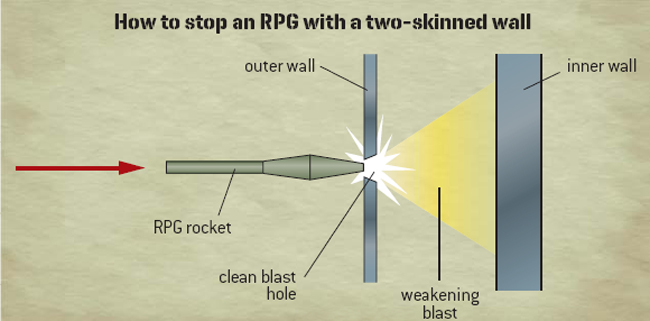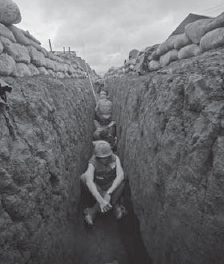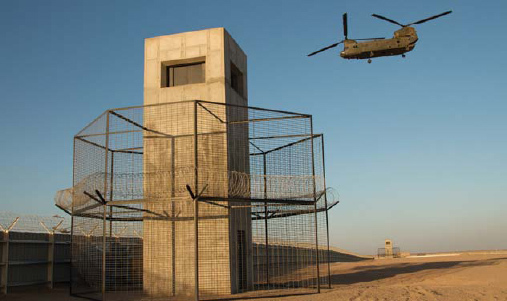TOP TIP!
Digging technique
The ideal way to build a base is to have the engineers come with heavy plant machinery and either digs holes for you or fill those lovely big bags they have with sand. Failing this, have one man loosen the earth with a pick and the other scoop it out with a shovel. This way is much easier and quicker than any alternative. Try never to break packed earth with a shovel or spade.
If you can get hold of a bunch of sandbags then you can cut down on the amount of muck you have to move. If you dig down 18in then you have sufficient earth to fill enough sandbags to build a wall 18in high around your hole. This not only makes for less work but gives you a raised shooting platform with a better view of approaching enemy creeping along the ground.
If there is constant heavy rain your hole is going to get wet and muddy unless it is in sand. There is nothing you can do apart from dig a ‘sump’ and keep baling it out. Constant rain is like Chinese water torture and really gets you down after a while – trust me the effect of the constant beating of rain on your head has to be experienced to be truly believed.
Sandbags
Ordinary man-portable sandbags about 18in long are very useful for constructing a bullet proof wall out of next to nothing. A dozen empty bags weigh ounces but filled with ‘muck’ a sandbag placed lengthwise will stop a rifle bullet at point blank range. This is because the sand or earth spreads the force of the strike outwards from the point of impact in a cone and it is dissipated in moving a lot of sand a little way. With a little imagination you can find all sorts of ways to improve your condition by the use of sandbags. You can also create little walls between foxholes to allow movement under cover without endless digging.
A raised shooting platform which allows you a better shot at the enemy than firing from ground level is a good idea too. It also reduces the chance of bullets bouncing up at your face from the floor. If you do this remember that a sandbag wall is a magnet for the RPG rocket. Because the blast from this weapon travels forward with tremendous force one layer of bags will not save you. More likely you will be sand-blasted to mush and cooked at the same time. The way to proof a wall against RPGs is to build a single wall outer layer to set off the charge and a double inner layer to absorb the force of it.
While single-man holes are the safest and most efficient in terms of spreading out your forces to cover a perimeter and minimizing loss of firepower from casualties, it is a fact that many men ‘soldier’ better with their mates by their side. If circumstances permit you might want to consider allowing double or group holes to allow for a communal smoke or game of cards in between the shooting matches.

Trenches
A trench is only a long hole but it has several features not at first apparent: on the positive side it allows the movement of firepower to where it is needed without exposure to enemy fire. It also allows good command and control – and the sight of officers and friends is good for holding the men together in a warm action.

Khe Sanh, a remote US outpost in Vietnam, faced full-scale siege from the North Vietnamese forces during the Vietnam War until it was finally abandoned two months after the siege began. Someone there knew how to dig trenches. March, 1968. (Corbis)
On the down-side an enemy standing at the end of a trench can kill everyone in it with a burst of fire or a few grenades. One mortar hit is likewise destructive. The classic way around this problem is to dig the trenches in a zigzag pattern. It works but it is a lot of digging.
Gun pits
A machine-gun hole needs to be a little larger and will benefit greatly from a raised firing position if the situation and manpower permits. As it is a focus for any serious assault you might want to consider a roof to stop grenades or aimed mortars.

HQ and support bunkers
With a unit larger than, say, platoon size (36 men) it becomes useful to centralize command, signals, medical aid, ammunition supply and ration stores. Each of these can have its own bunker which should be large enough to accommodate the relevant personnel as well as their materiel. Because each of these groups are of great importance to the whole formation it is usually sensible to build them a bomb-proof roof wherever possible. As it is already becoming clear on operations you will always be working either as a donkey or a mole.
TOP TIP!
Alternatives to digging
There are three common alternatives to digging holes yourself: you can get the engineers to dig the holes with machinery, use explosives if you are lucky enough to have them on hand – or failing one of these blessings you can persuade the locals to dig the holes for you. A food for work programme often works well.
Getting the locals to dig holes is the most common and preferred alternative of the seasoned infantryman as you can bet your last dollar the locals will happily dig you an excellent hole for a can of something meat-related: and then they will immediately trot off to tell the local insurgents where you are. Either because they hate you or they don’t want the insurgents to cut their bits off. In any event, this saves you endless patrolling and sore feet with the added benefit that you are fighting from a prepared position chosen by yourselves at leisure. I have used this trick countless times and it has never failed.
Buildings
You may well have to hold buildings against attack. The problem is that roofs create air burst over your head from mortars and heavy machine guns and RPGs go straight through most brick walls. The reason is that brick is a brittle material and doesn’t spread the shock of impact all that well compared to packed sand or gravel. Your best bet is to build a second skin to the walls you intend to shelter behind out of sandbags so as to trigger and suppress RPG rockets and provide some protection against heavy machine guns.
For sure a heavier type of weapon such as a cannon shell or a machine gun of greater than rifle calibre will make short work of a wall whatever you do to reinforce it. The best thing is to dig holes for shelter and fire positions and use the building for cooking.
Towers
Some permanent bases have towers already built so presumably they were built properly. With a tower you get a great view of the enemy from a comfortable, dry position and should be able to fire onto anyone creeping towards your position. This is a blessing. Less good is the ability of an RPG or .50cal machine gun to punch holes in anything but the stoutest tower.

Concrete watch towers with wire surround to prevent RPG7 damage by detonating them too early. I would prefer that wire to extend above the top of the tower. Camp Bastion, Afghanistan, September 2010. (Corbis)
DEFENSIVE POSITIONS: SELECTION AND LAYOUT
As every defensive position is different owing to the ground, weapons available, defending strength and so on, I am going to show you what to look for in selecting a defensive position and how to lay out the perfect defence. You can then mix and match the principles to cover the less-than-perfect circumstances in which you will doubtless find yourself.
At the root of the layout issue are the two conflicting requirements of a defensive position: these are to be spread out as much as possible against mortars or artillery and to be as small as possible so your forces and weapons are spread around as short a perimeter as possible. It doesn’t take an ‘Einstein’ to see that the shorter the perimeter you are defending the closer your guns are together and therefore there more concentrated the fire which an attacking force has to endure.